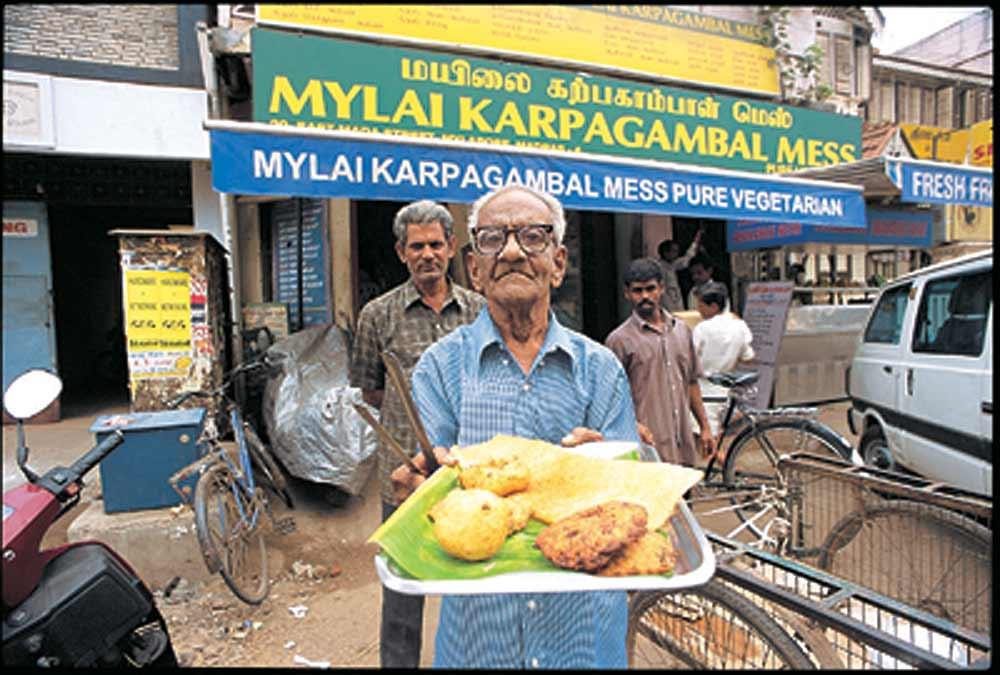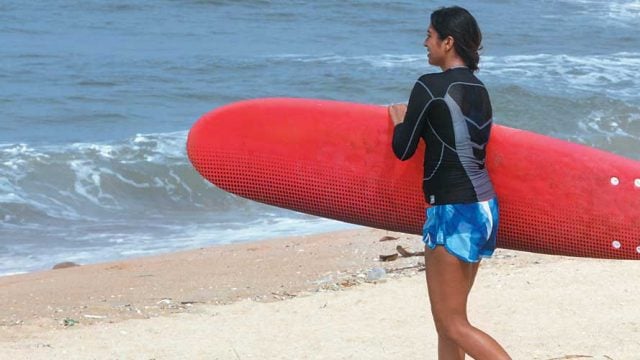As someone with more than a passing interest in the business of eating, the people I most
It had been eight years since I last visited Madras. So it was with some trepidation that I made the journey last month. Would Madras be the worse for wear? To my relief, I found many things had indeed changed — for the better. In the Madras of the 70s and 80s, a non-vegetarian searching for Tamilian food could have problems. Unless one was a soldier and was expected to eat meat in a military hotel to make oneself more manly. For the rest of us, the only fish was seer with the occasional prawn. Today, there is everything. There is rabbit, turkey, country chicken, quail, pigeon…even a ‘From the Forest’ section on the vast menu of Anjappar Chettinadu Restaurant. Not bad for a city that never ate out and, on those rare occasions, wouldn’t be caught dead eating anything but tiffin. Everywhere, there is Chettinad and only Chettinad. So what if the owner hails from Usilampatti, and the chef from Sirkazhi, a good many kilometres away from the 80-odd villages that comprise Chettinad?
Conjured up in the bangalas of Chettinad, Devakkottai and Karaikudi of south-central Tamil Nadu by the Nattukkottai Chettiars, Chettinad cuisine with its spicy meat dishes and strong liking for game, is a world away from pure vegetarian tiffin. Introduced in Chennai’s restaurants by military hotel cooks, Chettinad cuisine now has a global following. Sadly, almost anything that’s South Indian and non-vegetarian is now called Chettinad — even if it’s Malabar chicken curry.
Less well-known but not terribly different from Chettinad food is the cooking of the Mudaliars. The use of vadagam (a concentrated spice mixture) and kalpasi (a type of fungus — a fallback to the days when Mudaliars were hunters), fish curries cooked in stone kal chattis and a subtler use of spice, mark Mudaliar cooking. You don’t need to search for Mudaliar food in Chennai. Almost all Chettinad restaurants have a generous variety on their menu. You just need to know what to look for. For starters, there’s the vazhaipoo vadai, made with ground banana flowers and kadalai flour mixed with a host of seasonings, chopped onions and chillies and deep fried. Ladies finger, yam, bitter gourd and colocasia diced, smeared with turmeric, coriander and chilli and deep fried are typical Mudaliar bajjis. Kathirikkai varuval (brinjal stuffed with masala and cooked in a sour gravy), pakoda kozhambu (balls of Bengal gram with fresh green masala simmered in a curry), kathirikkai kosamalli (a thick brinjal sauce with potatoes that’s as sour as it is spicy and delectable), the tangy vathal and milagu kozhambus (tamarind and pepper gravies), are all Mudaliar. The phenomenal Saravana Bhavan chain even serves a bit of vadagam on the side with their thalis, which today you can order online in Chennai.
If you have a couple of days in Chennai and want to sample Tamil cuisine in its home kitchens, this is a short list of suggestions—but there are probably a hundred more restaurants as good. A good place for a first-time sampling of the meaty parts of Chettinad cuisine is at Kaaraikudi. Their signature Chettinad pepper vhicken and mutton cooked with drumsticks is the best you could have, and the seafood is beyond compare. They also do thin slices of pigeon in a spicy dry fry. I tried it, but was put off. But this only reflects my inability to think of pigeons without recalling the odour of guano. The seafood, fortunately, was familiar and delectable. Try the sora puttu, or scrambled shark.
Anjappar’s Chettinadu Restaurant in Pondy Bazaar is good, especially if you’re trying rabbit — a Chettinad favourite — for the first time. Wade past the stalls hawking idli-batter grinders and heavy-duty tiffin carriers to the soft, soft kal dosais, perfect to soak up the fiery spice of the fish curry. Chettinad rabbit chukka fry is a wonderfully spiced dry fried dish. Usilampatti in Thiruvanmiyur offers a spicy-sour karivepillai rasam that clears the palate for the quail to follow, but the wait was sadly not worth it. The tiny bird was cooked too long and the meat was tough and leathery. Still, the nandu roast and prawn varuval were good. The must-tries here are the Mudaliar dumpling curries — the paniyarams and pakoda kurmas.
For a soul-food vegetarian detour back to the heart of traditional Madras tiffin, make your way to the heart of Madras itself, in the streets along the Kapali Kovil tank in Mylapore. Chennai’s history began in Mylapore; there’s no better place to go for a take-it-for-granted saapaad. Specifically, to the messes of Mylapore, old bachelor hideaways till the winds of change blew out the machismo and welcomed ladies in. Primary among them is the revered Karpagambal Mess, opposite the Bharathiya Vidya Bhavan. The atmosphere is old Madras, the food is Iyer Brahmin. The best things to eat here are what you think of when you think of South India — nallennai dosai, adai, vadai and pongal.
Mami Kaiyendi Bhavan, near the temple, and Murudi’s, on Luz Church Road, are almost as good as Karpagambal for old-time feel. You will need a cup of coffee to keep walking after Karpagambal, and you can’t do much better for that than at the Rayar Café. You can specify how long you’d like your coffee: one metre if an afternoon nap is part of your day; two metres to keep you in business after a Karpagambal meal. The longer the coffee — that is, the longer the waiter stretches the steaming drink to cool it — the more you pay. Having drunk the best and strongest coffee in India, you will most likely be in a position to experience the best military hotel in India.
If there was ever a restaurant one would stake one’s reputation on recommending, it is Velu Military Hotel. When I went to Velu, it was at the height of a Madras summer. The whole morning and most of the afternoon is spent in a heat-induced daze, when all your vulnerabilities are on display and awaiting exploitation. It was in this state that I walked into the gents’ area and was shooed out by alarmed customers, up another flight of steps to the family room. Up here, all were whispering. The aroma of hot rice permeated the air. A smiling face hovered through the heat, somewhere above my forehead. A voice said, “Saapaad?” And all one could do was say, “Yess.”
A beautiful plantain leaf was placed delicately under my nose, then decorated with a huge heap of rice. Two vegetables were dunked on the side and a thick chicken gravy (no pieces) was poured over. I panicked and checked that this was indeed a military hotel. Yes, I was told. Disappointed (no pieces), I began to eat. Then, out of nowhere, the smiling face was back, with a gigantic tray lined with 20-odd kutti plates of magic. Golden fried prawns, fat chunks of fish swimming in gravy, chicken masala, mutton dry fried with coconut, anchovies swimming in oily curry, spicy liver. Each one was pointed out with a whisper. “Mutton, mutton, mutton. Prawns, prawns, prawns. Brain, brain, brain.”
It was enough to make a meat lover weep tears of gratitude and awe. From this smorgasbord of perfectly cooked curries and fries, you take anything you like, which could conceivably be everything. You eat till you are full, then go on till you barely have space left for a sip of water. Then, the smiling face comes back and gives you more. You are now in a heat-and-spice-induced stupor. It takes a lot to convince the waiter you truly don’t want anything more. Rising to pay the bill, I found to my horror another heap of rice being dunked onto my leaf. “No, no, illai, illai, nandri,” I said desperately, my self-image as a gastronome in tatters. There were tiny girls here with jasmine in their hair, illicitly meeting boyfriends, all a third my size. And they had that second heap of rice. Yet again, Madras set a higher standard, without attaining which it seemed I could never be a true epicure. Even if I did wash my plantain leaf like a local.
I paid the bill, a grand total of Rs 55, and made to flee. To step out into a Chennai afternoon after a lunch like that was daunting. But it was only another hour till the 3pm breeze, when one can make one’s way to the shady casuarinas on the beach. On the Western Coast, there are simple rules for interaction with the sea: when the tide is in, you swim; when it goes out, you don’t. In Madras, whatever the tide, you don’t swim, for the Bay of Bengal is a treacherous sea with treacherous currents, good only for its fruit. If you want to make it back to sample the seafood at the stalls on the Marina, stay out of the water.
Coastline Restaurant is a good place to experience seafood. The menu is varied: from ‘marcha jhol’, ‘udong sambal’, ‘fish Moile’ to ‘fish do piaza’. A good option if you need a change of flavours to underline the brilliance of Tamilian cuisine. I recommend the Chennai yerra (prawns) and nethili (anchovy) varuval. Crisp appalams at Taj Coromandel’s Southern Spice, followed by a seafood platter of peppery squid, crisp nethili, spicy jumbo prawns and a metre-long coffee are good options.
A stone’s throw from the beach in Besant Nagar, Ponnuswamy’s Mess and Bananaa Leaf are great options if you’re in the Adyar area. Bananaa Leaf is good for kola kozhambu, the famous meatballs of Chettinad. Pepper-fried nandu (crab), messy but delicious, and chicken fry from Devakkottai are served here with delicate idiappams soaked in coconut milk. The best dish here is the mutton varuval, cooked with flecks of coconut meat, mustard and curry leaves.
Even more impressive, set amidst the ruins of Kovalam Fort, a 45-minute drive out of Madras and on the shores of the Bay of Bengal, is the Bayview restaurant at Taj Fisherman’s Cove. The aroma of salt and seafood is itself an appetiser, but a few sips of coconut water or a strong Screwdriver can speed things up. The yerra fry (masala-fried prawns), or kadamba meen varuval (fried squid rings) are even better appetisers. For the main have the kezhangan (lady fish) cooked in a tomato gravy with plenty of curry leaves. The chef at Bayview travelled down the Coromandel coast, diving into kitchens at appropriate intervals and pulling out previously unknown gems, like the Tuticorin parotta and Kovalam meen kozhambu. Finish off with a bit of fusion which actually works — a delectable tender coconut mousse.
To reproduce in your own kitchen the subtleties and glories of Tamilian cuisine takes practice and discipline. You only match up when you no longer need a book to make Thanjavur lemon rice or Devakkottai chicken. But you could save yourself the bother and make your way instead to establishments like Grand Snacks and Sweets, or Ambika Appalam. At the latter, stock up on supplies of Ambika Appalam No 1, Ambika Appalam No 2, and so forth. With a few packets of pulikachal paste and karivepillai podi, you’ll be making Tirunelveli manoharam like the professionals near the Kapali Temple — even if you can’t say vazhaipazham without stumbling.
Chettinad cuisine
Madras
Tamil cuisine
Leave a Reply
You must be logged in to post a comment.





